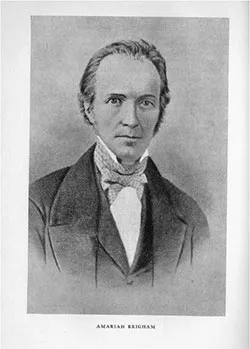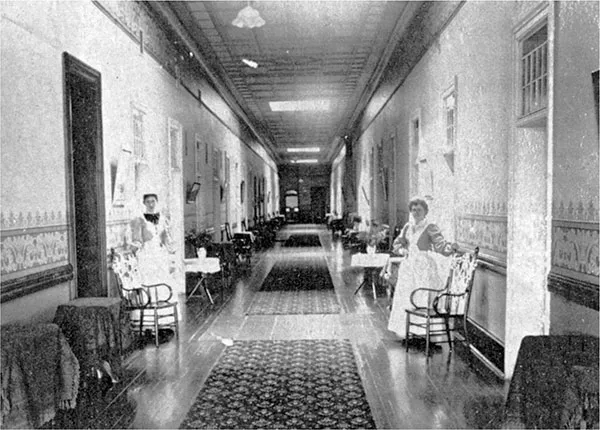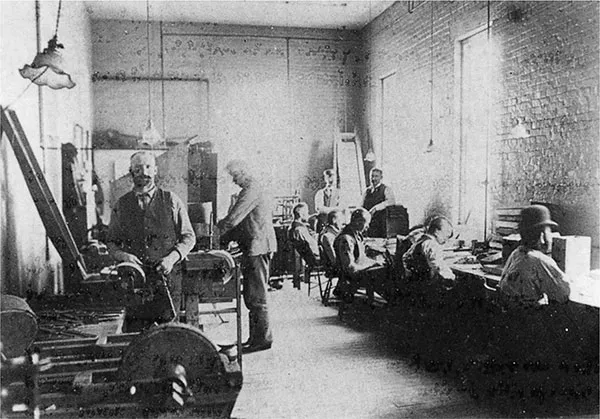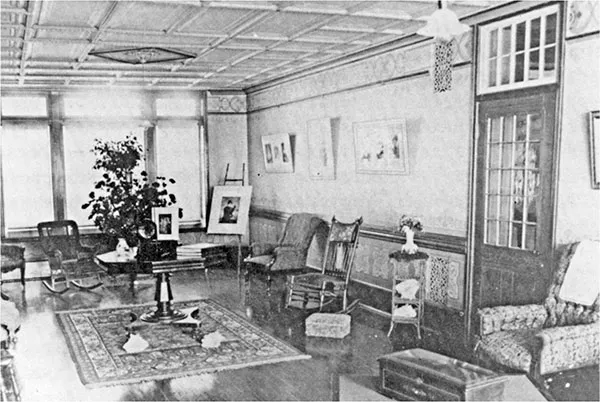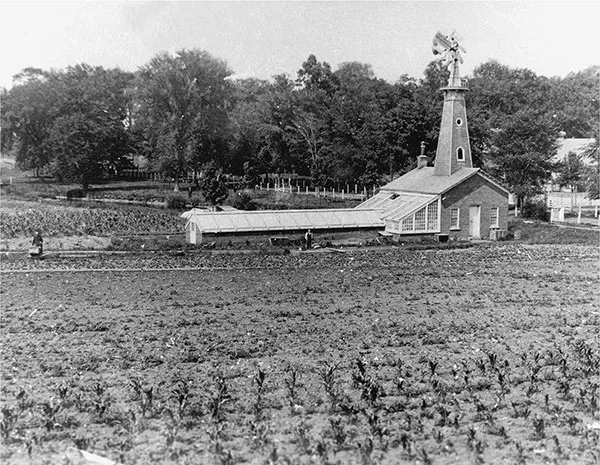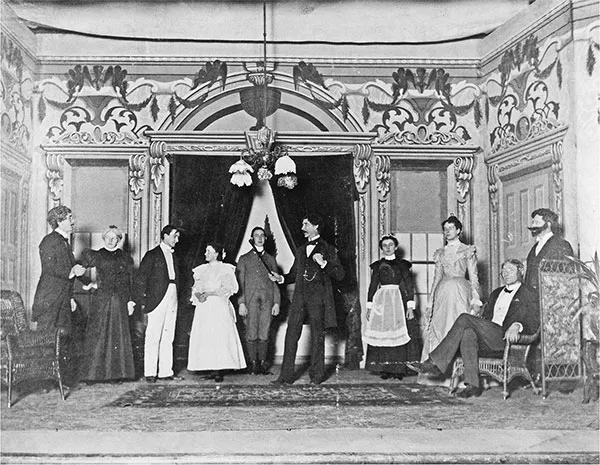![]()
PART I
New York State Lunatic Asylum at Utica (1843–1889)
AMARIAH BRIGHAM, MD (1843–1849)
Dr. Brigham was the first superintendent of the New York State Lunatic Asylum at Utica. His innovations included bringing occupations to the patients. He viewed it as healthy to the mind to work and have purpose. He had a working farm that had chickens, horses, pigs and cows along with a vegetable garden, a beehive and a print shop. Jobs included carpentry, kitchen duties such as meal preparation, cleaning, seamstress work and many others. Instead of chaining people to walls, he put them to work. Dr. Brigham used Shaker methodologies, which included a very strict day. (The Shakers were a Christian sect known for strict rules, including mode of dress.) Bells would ring when patients were to rise from bed, go to meals, go to bed and go to church. Everyone had to wear Shaker-style clothing, and it was laundered every day along with the bedding. Dr. Brigham started the American Journal of Insanity in 1844 in the print shop and invented the Utica crib. Amariah Brigham was born on December 26, 1798, in New Marlborough, Massachusetts. When he was eleven years old, his father passed away, so Amariah went to live with his uncle in Schoharie, New York. Amariah dreamed of being a physician—as his uncle was one of high regard—but when Amariah was fourteen years old, his uncle passed away. The lad went to Albany to live on his own. Eventually, he went back to Massachusetts to live with his mother and started to study under physicians. He became a physician and was successful for many years in the United States and abroad. He would marry and had four children, with his only son dying at the age of twelve in 1848 from a dysentery outbreak in Utica. Dr. Brigham served as the superintendent for the Retreat of the Insane in Hartford, Connecticut, before he received the assignment of running the New York State Lunatic Asylum at Utica. Dr. Brigham came to Utica to take over the largest and most expensive asylum ever built up to that point and the first of its kind in New York State. He opened the asylum in January 1843, when only the front part was finished, and it quickly filled. More room became a necessity He had the stressful work of overseeing structural changes and completions, hiring and training the staff, all the while pushing forth his innovative approach to patient care. Additional funds of $60,000 were acquired, and the two wings were completed by 1847, bringing the total cost up to that point to $448,980. In the first year of operation, Dr. Brigham welcomed 276 patients from 48 counties with the new wings able to host up to 500 patients.
Official portrait of Dr. Amariah Brigham. Oneida County History Center.
That same year, Dr. Brigham brought on his assistant physician, Dr. H.A. Buttolph; Cyrus Chatfield, steward; Mrs. Chatfield, matron; Edmund A. Wetmore, treasurer; and staff to assist in the laundry, kitchen and other areas. The original staff numbered forty-one, and all took up residence at the asylum. In addition, staff members were banned from drinking alcohol or partaking in tobacco. Dr. Brigham admired Dr. Philippe Pinel, a leader of mental illness treatment who took patients out of dungeons and chains. Pinel was of the opinion that mental illness was a disease. At that time, many thought it was possession or the devil taking hold. There would be no dungeons or chains under Dr. Brigham’s tenure, and he used reinforced rooms for violent and noisy patients, along with leather or cloth mittens, leather muffs and wristbands. This civil and humane treatment was much different than at the poorhouses, almshouses and jails in which they had been hidden away. When violent patients arrived at the asylum bound in chains, Dr. Brigham would have them taken off right then and there. He put them to work in fresh air with occupational purpose. In stark contrast, Dr. Brigham invented the Utica crib, which was like a baby crib but adult size with a lid that would lock down and hold the patient in place. This device became the most popular restraint in the world and would be in mass use for the next forty years.
Dr. Amariah Brigham’s grave at Forest Hill Cemetery at Utica, New York. Courtesy Dennis Webster.
Dr. Brigham was considered the leader in the “cult of curability” and considered “manual labor as the most essential as a curative means.” He had patients in various occupations within and outside the asylum that he felt would cure or assist in their mental well-being. He also started the first fair at the asylum, where patient-made items would be for sale. This fair was January 1844 and featured needlework, carved dolls and wooden utensils. The fair was a huge success, based on the superior quality of the made items—so much so the New York State Fair came to Utica the next year and Dr. Brigham had a booth with the patient items on display and for sale. The quality of the goods won numerous awards for the patients. The American Journal of Insanity was created at the asylum and boomed to national sales and is still published today as the American Journal of Psychiatry. Dr. Brigham was a prolific writer and published many books on the anatomy of the brain and mental treatment. He also kept a huge number of books on mental illness in a large library that was turned over to the asylum after his death.
Andrew Jackson Downing designed the grounds of Old Main in the picturesque Gothic style. Oneida County History Center.
Dr. Brigham was highly respected nationally and testified at the trial of a Black man, William Freeman, who was accused of murdering four people in Auburn, New York, on March 12, 1846. Brigham would be thrust in a powerful trial that pitted the then state attorney general John Van Buren, son of President Van Buren, on the side of the prosecution with William A. Seward for the defense. The community wanted a public hanging, which was common for murderers of the time. It wouldn’t be until later in the century that hangings were replaced with the electric chair—at Auburn, of all places. Freeman had just been released after serving five years in state prison when he was accused of committing murder. The defense called Dr. Brigham to testify to bolster its claim that William Freeman was a lunatic and thus deserved to be committed to an asylum and not put to death. The prosecution jumped when Dr. Brigham declared he could diagnose insanity just by looking at a person. The prosecuting lawyers made the audience abuzz when they asked Dr. Brigham to scan the crowd and point out anybody who might be insane. He scanned the room with what was described as a “piercing brilliant gaze” as he looked into the eyes of each person. Dr. Brigham came upon a stable hand who had wandered into the courtroom, pointed at the man and declared, “Here is your insane man.” The crowd erupted, and the man jumped up and had to be restrained by officers, who cleared him from the courtroom. This made the crowd come to Dr. Brigham’s side, and his testimony kept Freeman from hanging, although the man was declared guilty of murder in the first degree and spent his life in jail. This incident has gone down as one of the most dramatic courtroom scenes in history.
Matrons in the halls inside Old Main. New York State Archives.
Patients on their job at the asylum workshop. New York State Archives.
Lounge where patients could relax. New York State Archives.
Dr. Brigham has been described as a difficult, stubborn, opinionated man, yet he was also a tireless advocate and worker who wanted to not only cure mental illness but prevent it as well. He helped usher in a new psychology in America and inspired many to take his theories further and improve them. The number of patients swelled under the leadership of Dr. Brigham. In 1847, the Lunatic Asylum was the largest in the United States, with 380 single rooms for the insane, 24 for their caregivers, 20 dormitories that could accommodate 5 to 12 persons each, 16 day rooms, 12 dining rooms and 24 bathing rooms, with the same number of water closets and clothing closets. A gas system of lighting was added at an additional cost of $5,000.
Adding to the stress on Dr. Brigham was the legislature, which passed a law allowing the transfer of the criminally insane to the asylum. Homicidal maniacs would bring all sorts of challenges for the staff and stresses on the current patients. All counties but three in New York State sent lunatics to the asylum. In 1848, overcrowding became a reality; there were 877 patients in the asylum that year. In his last report on the asylum in 1848, Dr. Brigham listed 2,014 patients admitted since the opening. All were not charged to the public; some had paid by their own means or by family or friends. These private-pay patients paid from $2.50 to $4.00 per week, while New York State paid $2.00 per week for the indigent. Brigham was fiscally responsible and said to have had “Yankee thrift,” along with his trusted treasurer, Edmund Wetmore. After a short illness, Dr. Amariah Brigham died at the age of fifty-one on September 9, 1849. His remains are buried in the grand and historic Forest Hill Cemetery in Utica, New York.
MORAL TREATMENT BY DR. BRIGHAM
Dr. Brigham was a leader in the field of “moral treatment” and put his theory to the test when he became the first superintendent of the New York State Lunatic Asylum at Utica. Dr. Brigham put forward his opinion in an extensive article in the American Journal of Insanity. He had started this progressive medical journal right in Utica at the asylum building. In the article, he states that when an insane person is removed from the home, they should be treated with respect and dignity. They would be placed in an asylum that would teach self-control through manual labor, a strict regimen of life to distract the mind from morbid thoughts. There would be mandatory religious services on Sundays, occupations and a range of activities essential to moral treatment of the insane.
The moral treatment was also a deciding factor in setting up the Lunatic Asylum at Utica. Dining halls, lounges, rooms and workshops would all look like patients’ homes or places of employment. They would no longer wear ragged, dirty clothing; instead, asylum residents would don matching, clean clothing that would be washed and pressed regularly. The attendants, nurses and other staff would wear neat, clean uniforms to be professional. When visitors, families or dignitaries walked the hallways of Old Main, they were pleased to see the patients in a clean, well-run facility.
The Utica State Hospital farm provided work for the patients and food for their table. New York State Archives.
Patients of the asylum putting on a play for fellow patients and staff. New York State Archives.
Asylum stage where minstrel shows, plays and the asylum band played. Oneida County History Center.
In his writing, Dr. Brigham mentioned Pinel treating patients with kindness but some places in the world still treating the insane quite brutally. He acknowledged the belief of lunacy being handed down by the devil but asserted that the better treatment of the insane had to do with an increase in knowledge. He said ignorance had caused the insane to be persecuted, mistreated and put to death in the past. The patients of the modern nineteenth-century asylum were not witches, heretics or devils; they were human beings with diseases that are sometimes difficult to diagnose. The spread of science helped to end heretic diagnosis.
Dr. Brigham called Pinel bold and brave for unchaining fifty maniacs at the Bicetre Hospital in France in 1792. Pinel made this move after vast learning and research into the insane. He tried his moral treatment system for several years before publishing it to the world. The system would be adapted and changed as it progressed to England then America. Dr. Brigham added elements such as occupations and activities. Giving the mentally ill tasks like coo...

